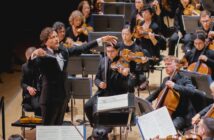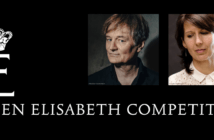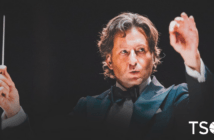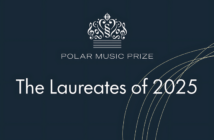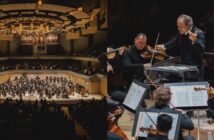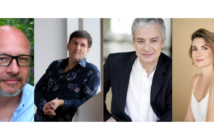by Giuseppe Pennisi
Music is the best medicine to cure cancer according to Maestro Claudio Abbado. Doctors removed much of his stomach and he can only eat small amounts at a time.“I found a new life, without a stomach,” he states. “I think differently. My senses are different.” His music-making has also changed: “I hear more lines now; I hear sounds I never heard before.”
Unfortunately, the therapy has weakened him: it’s now a special occasion when Maestro Abbado conducts. At 77, Abbado has mostly turned away from the kind of grand institutions he once led — La Scala, the Vienna State Opera, the Berlin Philharmonic. He pours his energies mainly into a few bursts of concerts, preferably with “his own” orchestra, the Bologna-based Mozart Orchestra. Now on a grand tour, which started in Reggio Emilia in March and continued in Rome (three concerts produced by the Accademia Nazionale di Santa Cecilia as a part of the subscription series) and, after a pause in April, the orchestra will proceed to Milan, Ravenna (as opening event for the 2010 Festival), Paris and Ferrara.
Abbado has turned away the distractions of modern conducting, like administration, dealing with unions and constant travel. He plays the music he wants with the musicians he chooses. Altogether he conducts about 30 concerts a season, dividing his time between homes in Bologna and Sardinia, where in the garden at his villa he has put in 9,000 plants. As a payment for his early June Milan La Scala concerts, he asked that the city plant 9,000 trees in the brick-and-mortar town. The Milan City Council is obliging … and following through on the contract.
The Mozart Orchestra was conceived by Carlo Maria Badini (a former La Scala Superintendent) as a special project of the Philharmonic Academy of Bologna, thanks to a decisive contribution from the Fondazione Cassa di Risparmio of Bologna (the Bologna Savings Bank Foundation). The Orchestra, like the OSR (see La Scena in November 2009), is a very rare example of a privately funded symphonic formation in Italy. It has 40 permanent instrumentalists (versus 90 in the OSR); this means that for works requiring larger forces (i.e. those by Mahler, Bruckner, Strauss and Nono), the Mozart Orchestra needs to contract extra-musicians or to join another ensemble–in June in Milan it will join with the Filarmonici della Scala. Maestro Abbado became Artistic Director of the Orchestra, and improved its profile by inviting such internationally-renowned instrumentalists as Giuliano Carmignola, Danusha Waskiewicz, Wolfram Christ, Enrico Bronzi, Mario Brunello, Alois Posch, Jacques Zoon, Alessandro Carbonare and Alessio Allegrini.
The Orchestra is a truly international ensemble with young musicians from all over Europe (Italy, Spain, France, Germany, Austria, Holland, Norway, Finland, Hungary and Russia). It made its debut on November 4, 2004 at the Manzoni Theatre in Bologna with Abbado at the helm. Since then other great conductors such as John Eliot Gardiner, Ottavio Dantone, Trevor Pinnock and Frans Brüggen have led the orchestra. On 25 October 2008 at Pala Dozza in Bologna, the Orchestra Mozart played a memorable performance of Te Deum by Berlioz, together with the Cherubini Youth Orchestra, the Italian Youth Orchestra, the Choir of the Municipal Theatre of Bologna and the Giuseppe Verdi Symphony Choir of Milan. The impressive choir of treble voices was made up of more than six hundred children. On 13 June 2009, after the Abruzzo devastating earthquake, at the Auditorium of the Guardia di Finanza (Finance Police) School in Coppito (AQ), Abbado and the Mozart Orchestra dedicated a concert to the people of Abruzzo affected by the disaster. At the same time, they also promoted the “Mozart Orchestra for Abruzzo”, Una Casa per la Musica (A house for music) initiative, to raise funds for the creation of a structure in which all the musical organizations of L’Aquila can resume their activities immediately.
On March 28th, in the packed 3000 seats Sala Santa Cecilia in Rome, the orchestra performed the “Italiana” Symphony by Felix Mendelssohn Bartholdy, the Mozart Violin Concert K. 216, the “Jupiter” Mozart Symphony K. 551 and, at the insisting request for “encore”, a real bonus, Beethoven’s “Egmont” Ouverture. The four different pieces have a unity; they are a bridge from the elegant XVIII Century – the two Mozart’s composition are like Brussels antique lace – to the XIX Century Romanticism – delicate and intimate in the Mendelssohn-Bartoldy “Italiana” (where places and situation are filtered through memory) and stormy and passionate in Beethoven’s “Egmont”.
Abbado’s baton kept a tight but flowing beat as his left hand, at the end of a thin wrist, went its own way, deftly sculpturing phrases and so often asking for less, less, less. Mr. Abbado moves with the deliberateness of someone conserving his strength. He conducted without a score. The audience erupted in real accolades.
However, there was a flaw: the violinist Giuliano Carmignola, a specialist more of baroque than of late XVIII Century, did not sound up to the level of the Orchestra.
Claudio Abbado’s Grand Tour with his Mozart Orchestra
0
Share:




